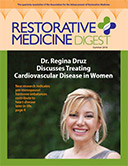The myocardium is vulnerable to injury from ischemia, hemodynamic overload, or pathogens. Irrespective of the cause, myocardial damage will activate innate and adaptive immune responses. The production of pro-inflammatory cytokines triggered by the innate immune response is initially cytoprotective. However, if the inflammatory response becomes dysregulated, chronic exposure of the myocardium to the ongoing production of pro-inflammatory cytokines can lead to left ventricular dysfunction (LVD). LVD is associated with many changes in heart structure and function, including negative inotropic effects, alterations in cardiac metabolism, remodeling of the myocardium, and eventual heart failure.1,2,3
Acute viral myocarditis, with or without concomitant LVD, is known to be an important cause of sudden death in the young. Those who survive with viral myocarditis live with a chronic infectious-inflammatory condition throughout their lifespan.4 It is also well recognized that upper respiratory viral infections can provoke acute myocardial infarction in vulnerable populations, such as the elderly. An association between, for example, seasonal influenza and cardiovascular mortality was first noted in the 1930s.5 Viral entry into the heart can cause injury directly. In addition, viral infections trigger inflammatory mediators, and promote a thrombogenic environment by inducing platelet activation and endothelial dysfunction.6 Infections also increase metabolic demand and can stress the cardiovascular system in a number of ways, including by inducing hypoxemia and hypotension, which can result in plaque rupture or formation of an occlusive thrombus.7
Mounting evidence suggests that some viruses can persist in heart tissue after an initial infection, and become reactivated under certain conditions, triggering a cell-mediated immune response that leads to myocarditis and, potentially, dilated cardiomyopathy. Dilated cardiomyopathy is a condition that permanently impairs heart function and can lead to heart failure or even sudden cardiac death. Epstein–Barr virus, cytomegalovirus, adenovirus, human herpesvirus 6, parvovirus B19, and coxsackievirus have been found in biopsied endomyocardial tissue taken from patients with cardiac inflammation.8 It is not yet fully understood if the persistent presence of viral genomes or proteins in cardiac tissue causes heart damage or exacerbates a pre-existing cardiac condition. The presence of viral genomes is often detected in heart tissue samples from healthy individuals who do not have clinical symptoms. However, when there is clinical pathology, the presence of viral genome or proteins in heart tissue is associated with a worse prognosis.9
There is some evidence that a viral infection can facilitate the reactivation of other viral species. SARS-CoV-2, the virus that causes COVID-19 infection, may reactivate EBV,10,11 as well as HHV-6 and HHV-7, which also belong to the Herpesvirus family.12 Dysregulation induced by SARS-CoV-2 in the host interferon response, a mechanism crucial for effective vigilance against pathogens, may be responsible for this reactivation.13 It’s not known if this is the same mechanism that is involved in reactivation of viruses that persist in cardiac tissue, but it is possible that different viral species from past and current infections may play a synergistic role in causing cardiac damage.14
Studies have identified the presence of SARS-CoV-2 viral proteins and genetic material in cardiomyocytes from pathology reports of patients with COVID-19, even in patients who did not have clinical signs of cardiac involvement.15 Heart failure is a common underlying risk factor for poor prognosis with COVID-19 and an independent predictor of mortality for the hospitalized COVID-19 patient.16 In the early days of the pandemic, studies suggested that people who did not have pre-existing heart conditions developed cardiac damage, potentially through direct viral or immune-mediated effects, after surviving COVID-19.17
A recent study examined the extent of cardiac damage and inflammation in the sickest patients with COVID-19. This study found that, of 342 patients hospitalized with COVID-19, who also had elevated troponin levels, 61% had cardiac abnormalities that included scarring from myocardial infarction or microinfarction. This was in comparison with 36% of 64 patients hospitalized with COVID-19 who had normal troponin levels, and 31% of 113 non-hospitalized participants of similar age, sex, and cardiovascular health status, who had normal troponin levels, and did not have COVID-19. In addition, the study found that the prevalence of myocarditis in patients with COVID-19 and elevated troponin was 6.7%, which is lower than that observed in earlier and smaller studies, compared to 1.7% in patients with normal troponin levels.18
This study suggests that patients hospitalized with COVID-19 may show an increased risk for heart damage, but there is less indication of the type of cardiac inflammation that previous studies found. The relationship between SARS-CoV-2 infection and heart failure is, however, clearly complex and warrants further investigation.
References
- https://www.jacc.org/doi/full/10.1016/j.jacc.2020.01.014
- https://pubmed.ncbi.nlm.nih.gov/31108102/
- https://pubmed.ncbi.nlm.nih.gov/28577862/
- https://www.ahajournals.org/doi/10.1161/circresaha.115.306573
- https://www.nejm.org/doi/full/10.1056/NEJMoa1702090
- https://www.ncbi.nlm.nih.gov/pmc/articles/PMC8537553/
- https://pubmed.ncbi.nlm.nih.gov/20113977/
- https://onlinelibrary.wiley.com/doi/full/10.1111/pin.12868
- https://pubmed.ncbi.nlm.nih.gov/34608239/
- https://www.ncbi.nlm.nih.gov/pmc/articles/PMC7486856/
- https://pubmed.ncbi.nlm.nih.gov/34035353/
- https://www.ncbi.nlm.nih.gov/pmc/articles/PMC7537064/
- https://www.nature.com/articles/s41577-020-0346-x
- https://www.frontiersin.org/articles/10.3389/fmicb.2022.1030440/full
- https://virologyj.biomedcentral.com/articles/10.1186/s12985-022-01833-y
- https://pubmed.ncbi.nlm.nih.gov/34517720/
- https://pubmed.ncbi.nlm.nih.gov/32219363/
- https://www.ahajournals.org/doi/10.1161/CIRCULATIONAHA.122.060632
